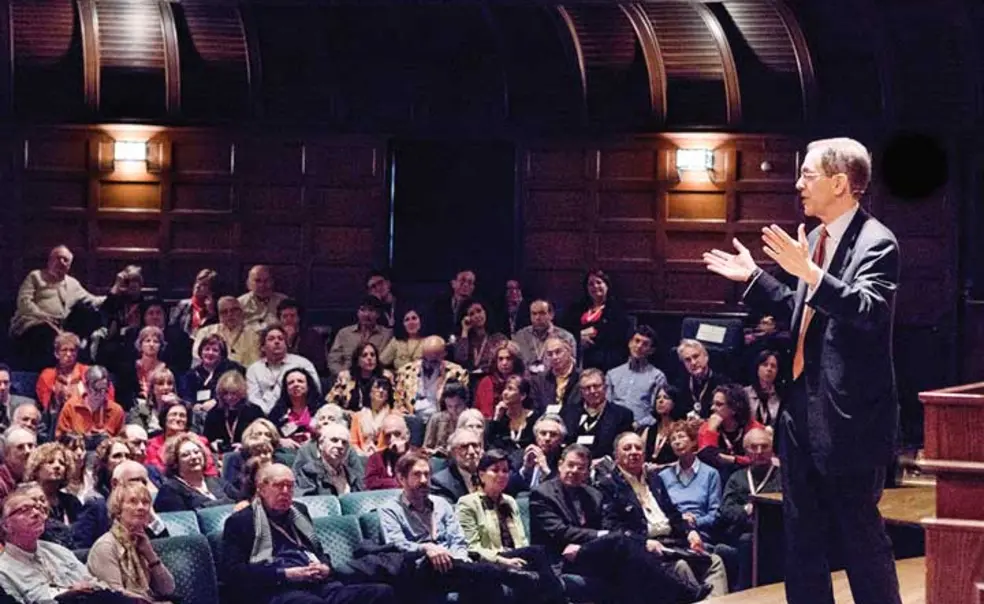Reflecting on Jewish Life at Princeton
Last month I had the pleasure of participating in “L’Chaim! To Life: Celebrating 100 Years of Jewish Life at Princeton.” The conference, organized by Princeton’s Office of Alumni Affairs, welcomed nearly 900 alumni and their guests back to campus to join faculty, staff, and students for three days of engaged conversation, learning, religious services, and shared meals — in short, to enjoy many of the activities that are constitutive of Jewish identity. What a long way we have come from the humble Shabbat service that started it all in 1915!
That service, organized by Frank Glick ’16, a popular student and captain of the football team, and David Kempner ’17, marked the first time that Jewish students had gathered for worship on the Princeton campus. Five years later, the University recognized the first Jewish student organization, and Jewish worship became a formal part of campus life. Friday night services even attracted some non-Jewish students eager to get the weekend’s Chapel requirement out of the way.
Still, Jewish students faced many challenges in their efforts to fit in at Princeton. They found themselves subject to harsh admissions quotas, stigmatized as “unclubbable,” and derided as “grinds” for their commitment to academic achievement as a means of upward mobility. Such institutional and social challenges persisted well past the middle of the 20th century, culminating in the infamous “dirty bicker” of 1958, in which 23 sophomores, 15 of whom were Jewish, were denied bids to eating clubs in spite of a commitment by the clubs to accept all applicants.
However, the years following World War II were already bringing important changes to higher education, as the GI Bill opened the doors of colleges like Princeton to a great influx of qualified students, including Jewish students, from diverse backgrounds. With increasing Jewish enrollment came the push for more official recognition, and the Student Hebrew Association was founded in 1947, becoming an official chapter of Hillel in 1948.
The presidencies of Robert Goheen ’40 *48 and William Bowen *58 also brought significant changes to the University’s efforts to build a diverse and inclusive campus community. Bowen made it a point to recruit Jewish students to Princeton. In 1988, Harold Shapiro *64 became the University’s first Jewish president, and he continued the progress his predecessors had begun. In 1993, Shapiro opened the University’s Center for Jewish Life, for which fundraising had begun in the Bowen administration.
Students like Marcus Lester Aaron ’20, who gathered the first minyan at Princeton in 1919, would be astonished by the variety and energy of the offerings at the center and around campus today. On any given Friday evening, one can attend Shabbat services in the Conservative, Orthodox, and Reform traditions at the center. Both the center and Chabad of Princeton, located just off campus, offer lively Shabbat dinners, and students sometimes flow between the two, eating their meal at one and showing up at the other for dessert.
Jewish life is evident throughout Princeton’s campus, including on Prospect Street. I was both amused and delighted the first time that I saw a sukkah (a temporary hut used for meals during the Jewish festival of Sukkhot) on the front lawn of Tiger Inn. Last month, seven of the 11 eating clubs hosted Passover Seders.
Another important step toward full inclusion of the observant Jewish community at Princeton has been the completion in 2015 of an eruv, or physical boundary, which encompasses the campus and surrounding streets. The eruv is an important accommodation to the realities of modern life, allowing observant students, faculty, staff, and guests of the University to carry items within its boundaries on the Sabbath.
Princeton has grown tremendously in the past 100 years as a place where Jewish students and scholars can thrive, but its old reputation persists in some corners. I learned that first-hand eight years ago, when I began identifying as Jewish after discovering that my mother had hidden her own Jewish past throughout her lifetime. My research into family history connected me to a network of cousins whom I had never known. Some of their friends expressed amazement that the provost of Princeton University — of all places! — could turn out to be Jewish.
I smiled and told them about Harold Shapiro’s presidency and the vibrant Jewish life on Princeton’s campus today — but also I admitted that Princeton had an exclusionary past. The L’Chaim conference took a similar approach, combining joyous celebration with honest remembrance of, to borrow the title of one alumni panel, “Jewish experiences across the generations.” That kind of candor — about exclusivity, about discrimination, about the students, faculty, and staff who struggled bravely for equality, about what we have achieved and about problems that remain — will be essential as we continue Princeton’s efforts to build a community that talented people of all groups and backgrounds can embrace as their own.













No responses yet